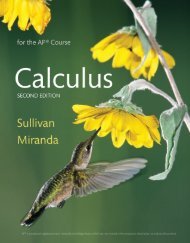SPA 3e_ Teachers Edition _ Ch 6
You also want an ePaper? Increase the reach of your titles
YUMPU automatically turns print PDFs into web optimized ePapers that Google loves.
Lesson 6.2 Sampling Distributions:<br />
Center and Variability<br />
If the mean of the sampling distribution of a statistic is equal<br />
to the corresponding population parameter, the statistic is<br />
said to be an unbiased estimator of the population parameter.<br />
Otherwise, the statistic is a biased estimator of the population<br />
parameter. The standard deviation of a sampling distribution<br />
of a statistic measures the variability of a statistic. The smaller<br />
the standard deviation, the more precise the estimate of the<br />
parameter. The variability of the sampling distribution of a<br />
statistic will decrease as sample size increases.<br />
Lesson 6.3 The Sampling Distribution of a Sample<br />
Count (The Normal Approximation to<br />
the Binomial)<br />
Let the random variable X be the count of successes in a sample<br />
of size n, where p is the probability of a success on a single<br />
trial. The sampling distribution of X will have mean m X = np<br />
and standard deviation s X = "np(1 − p). The Large Counts<br />
condition states that the sampling distribution of X will have<br />
an approximately normal distribution whenever np ≥ 10<br />
and n(1 2 p) ≥ 10. When the sampling distribution of X<br />
is approximately normal, probabilities involving the sample<br />
count X may be approximated by a normal distribution.<br />
Lesson 6.4 The Sampling Distribution of a Sample<br />
Proportion<br />
Let the random variable p^ be the proportion of successes in<br />
a sample size of size n, where p is the proportion of successes<br />
in the population. The sampling distribution of p^ will have<br />
p(1 − p)<br />
mean m p^ = p and standard deviation s p^ = . The<br />
Å n<br />
Large Counts condition states that the sampling distribution<br />
of p^ will have an approximately normal distribution whenever<br />
np ≥ 10 and n(1 2 p) ≥ 10. When the sampling distribution<br />
of p^ is approximately normal, probabilities involving<br />
the sample proportion p^ may be approximated by a normal<br />
distribution.<br />
Lesson 6.5 The Sampling Distribution of a<br />
Sample Mean<br />
Let the random variable x be the sample mean in a sample<br />
of size n from a population with mean m and standard<br />
deviation s. The sampling distribution of x will have mean<br />
m x = m and standard deviation s x = s . If the population<br />
"n<br />
is normal, then the sampling distribution of x will be normal.<br />
When the sampling distribution of x is exactly normal,<br />
probabilities involving the sample mean x may be calculated<br />
using a normal distribution.<br />
Lesson 6.6 The Central Limit Theorem<br />
The Central Limit Theorem states that when sampling from<br />
a non-normal population, the sampling distribution of x is<br />
approximately normal when the sample size is large. As a rule<br />
of thumb, when sampling from non-normal populations, we<br />
will consider the sampling distribution of x to be approximately<br />
normal when n ≥ 30. When the sampling distribution<br />
of x is approximately normal, probabilities involving the sample<br />
mean x may be approximated by a normal distribution.<br />
C H A P T E R 6 • Sampling Distributions 6-5<br />
Starnes_<strong>3e</strong>_ATE_CH06_398-449_v3.indd 5<br />
11/01/17 3:51 PM




